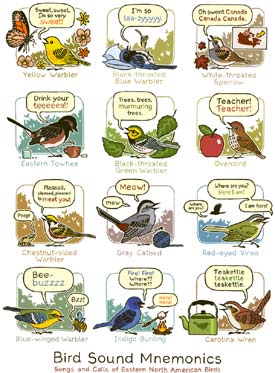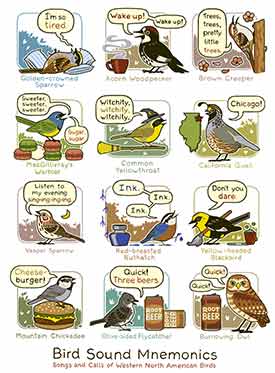3.25 miles
43rd ave, north/tunnel of trees/welcoming oaks/oak savanna/edmund, north/7 Oaks
49 degrees
Hooray for wonderful runs! Sunny, warm enough for shorts, clear trails, welcoming oaks, robins who sound like they’re singing “hurry up hurry up hurry up.” Ran on the trail but don’t remember looking at the river; too busy looking out for other people. After reading an article about “The Warbler Wave” at 7 Oaks, decided to end my run there and listen. According to local bird expert Dave Zumeta (I have his Birds of the Mississippi Guide pdf), mid-May is a great time to see/hear warblers as they migrate south, and 7 Oaks is the best place to do it:
Warblers are Zumeta’s favorite birds, bar none. He not only knows the subtleties of their markings, but can also recognize their songs. His favorite place to watch for warblers isn’t Costa Rica or the Greater Antilles Islands. It’s a sinkhole on 34th St. and 47th Ave. just a stone’s throw from his house. He said, “Seven Oaks Park is the reason we moved where we did. I think it’s one of the best places to bird watch anywhere – and it’s a warbler magnet.”
Wow, I love where I live! Here’s the recording I took as I stood on the edge of the sinkhole:
I have loved Marie Howe ever since I read one of her amazing poem from What the Living Do and listened to her On Being interview. Such beautiful words! Here’s one that features a bird:
From Nowhere/ Marie Howe
I think the sea is a useless teacher, pitching and falling
no matter the weather, when our lives are rather lakes
unlocking in a constant and bewildering spring. Listen,
a day comes, when you say what all winter
I’ve been meaning to ask, and a crack booms and echoes
where ice had seemed solid, scattering ducks
and scaring us half to death. In Vermont, you dreamed
from the crown of a hill and across a ravine
you saw lights so familiar they might have been ours
shining back from the future.
And waking, you walked there, to the real place,
and when you saw only trees, come back bleak
with a foreknowledge we have both come to believe in.
But this morning, a kind day has descended, from nowhere,
and making coffee in the usual way, measuring grounds
with the wooden spoon, I remembered,
this is how things happen, cup by cup, familiar gesture
after gesture, what else can we know of safety
or of fruitfulness? We walk with mincing steps within
a thaw as slow as February, wading through currents
that surprise us with their sudden warmth. Remember,
last week you woke still whistling for a bird
that had miraculously escaped its cage, and look, today,
a swallow has come to settle behind this rented rain gutter,
gripping a twig twice his size in his beak, staggering
under its weight, so delicately, so precariously it seems
from here, holding all he knows of hope in his mouth.
I love the idea of our lives as thawing lakes in a bewildering spring, and the kind day descending and things happening cup by cup, gesture by gesture, and the surprise of sudden warmth, and the delicate, staggering bird. The line about the bird reminds me of Ada Limón’s interview on VS:
Ada Limón: Yeah. I think, for me, there are a couple of new poems I’ve been working on. One of them, just recently, where I saw a beautiful kestrel that was on a really small branch. And I kept sort of loving this image of a heavier bird being held up by a small branch, right. And I kept thinking, I’ve got to do something with this, I’ve got to do something with this. And then, really, towards the end of the poem, I realized, like, I want this image to somehow tell me that as the branch, I can bear more, and I can bear a lot. And as the bird, I can balance on barely, you know, on something that’s barely there. And yet, in the poem, I recognize that it’s not telling me that, right. That that’s actually—all it is is a bird doing its thing, landing where it needs to land. And, you know, I want to look at those lessons. But I also need to pull back and think, okay, maybe it’s just a noticing, and that’s what my job was. And not always turning it into a … fable, you know. (LAUGHS) Or an idea that will somehow rescue the speaker. And in this case, you know, the speaker being me.
Franny Choi: Yeah, that helps me totally see what you mean when you say, allow the animal to be an animal alongside us as animals. Like To just like, be with them in an environment together, rather than being a colonizer like, be like, th, like, how is this tree useful for me? How is this bird useful? What can I -what can I make it for?
It’s interesting how these images of birds are opposites: Limón’s is too big for the branch, Howe’s is too small for the twig, but both are about the too-muchness of life—the world’s weight, too much for our small branched bodies, and hope’s sudden and unexpected appearance, almost too much to bear.
May 6/WALK
A break from running today. Took Delia on 2 walks instead, one just me, the other with STA and RJP. One down by the ravine, the other in the grass between the river road and Edmund.
Starlings/ Maggie Smith from Goldenrod
The starlings choose one piece of sky above the river
and pour themselves in. Like a thousand arrows
pointing in unison one way, then another. That bit of blue
doesn’t belong to them, and they don’t belong to the sky,
or to the earth. Isn’t that what you’ve been taught–nothing is ours?
Haven’t you learned to keep the loosest possible hold?
The small portion of sky boils with birds.
Near the river’s edge, one birch has a knot so much
like an eye, you think it sees you. But of course it doesn’t.
I’m not sure if I’ve ever seen starlings in person. I checked my bird list and they do live in the Mississippi Gorge. Maybe someday I’ll see them? Anyway, I picked this poem because it uses two interesting bits of information that I’ve wanted to use in a poem ever since I found out about them: 1. a boil of birds and 2. the tree with eyes.
a boil of birds
On March 9th, 2020, one day before I got my first of many sinus infections and just days before the pandemic became real in Minnesota, I went for a walk and noticed a big bird circling in the sky. Wondering why it circled, I looked it up and found out about thermals and boils of birds. Here’s what I wrote:
Thermals are updrafts of warm air that rise from the ground into the sky. By flying a spiraling circular path within these columns of rising air, birds are able to “ride” the air currents and climb to higher altitudes while expending very little energy in the process. Solitary birds like eagles and hawks often take advantage of thermals to extend their flight time as they search for food. Social birds that fly in large flocks also use thermals to gain altitude and extend their range during migration. The sight of dozens or hundreds of birds riding a thermal has been said to resemble the water boiling in a kettle, so the terms kettle or boil are sometimes used as a nickname for a flock of birds circling in a thermal updraft. The benefits of thermals are not limited to the animal world either as glider pilots often take advantage of them to gain altitude as well.
I want to see hundreds of birds riding a thermal and looking like water boiling in a kettle! Mostly so I can see them doing it but also so I can write about the boil of birds I just saw.
a tree with eyes
On June 18th, 2020, walking with STA and Delia the dog, we noticed a tree that looked like it had eyes. Here’s what I wrote:
Every day, in the late afternoon around 5, Scott and I take Delia the dog on a long walk between Edmund Boulevard and the River Road. This week, while stopped near the upper campus of Minnehaha Academy–the one that was recently rebuilt after the old building exploded a few years ago, Scott noticed all the eyes on an aspen tree and took a picture of it. I remember remarking, “oh, I bet there’s a name for that. I’ll have to look it up.” I finally did just now. The most popular answer? Aspen eyes. According to several sites I found, these eyes are formed through self-grooming, when aspens shed their smallest branches.
walking and listening this morning
On my walk this morning with Delia the dog, I heard black-capped chickadees, pileated woodpeckers, cardinals, and the red-breasted nuthatch I just identified yesterday. Also might have heard the plink plink of a bobolink–is that possible?Standing at the rim of the giant sinkhole that’s been turned into a city park at 7 Oaks, I heard so many other birds, including one that I hear all the time but I can’t yet identify. I manage to record it (along with other birds). \
Birding by ear is difficult and overwhelming at first. Too many different sounds that I can’t distinguish. So, I’m looking for tips, like these: Six tips for birding by ear. In it, they suggest some things to listen for.
Some things to listen for:
- is it high
- sweet
- does it rise or fall in pitch
- is it in groups of 2 or 4
- is there a space between each bout?


